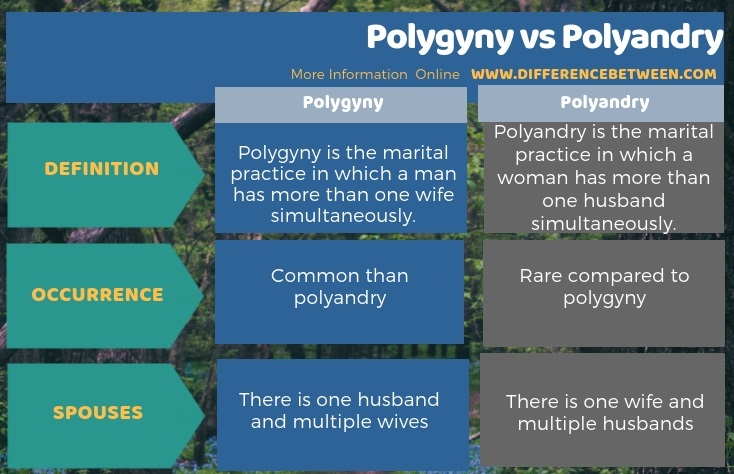Difference Between Polygyny and Polyandry
The key difference between polygyny and polyandry is that polygyny is the marriage of a man with several women whereas polyandry is the marriage of a woman with several men.
Polygyny and polyandry are two forms of polygamy as both involve having multiple spouses. While polygyny involves multiple wives, polyandry involves multiple husbands. Furthermore, both these practices are not very common in today’s society as most developed countries practice monogamy.
CONTENTS
1. Overview and Key Difference
2. What is Polygyny
3. What is Polyandry
4. Side by Side Comparison – Polygyny vs Polyandry in Tabular Form
5. Summary
What is Polygyny?
Polygyny is the practice of having multiple wives. In other words, this is a marriage in which two or more women share a husband. The term originates from the Greek poly meaning “many”, and gyne meaning “woman” or “wife. Here, a man can take multiple wives simultaneously or get married to one or more women when he is already married.

Figure 01: Polygyny
Although polygyny was a common practice in the ancient past, today it is not as commonly accepted as monogamy has become the norm. Most countries that practice polygyny are countries with a Muslim majority. Moreover, polygyny is more widespread in Africa than in any other continent. It is legal in Middle Eastern countries and some African countries such as Somalia, Uganda, Gambia, and Gabon. However, in countries like India, Malaysia, Sri Lanka, Singapore, and the Philippines, polygyny is only legal for Muslims.

Figure 02: Countries where Polygamy is accepted
Furthermore, in many societies, polygyny is usually common only among wealthy and powerful men. However, some agricultural societies may also engage in this practice as having multiple wives can provide additional labour. However, polygyny is generally considered as a practice with adverse effects as it tends to degrade women.
What is Polyandry?
Polyandry is the practice of having more than one husband. In other words, this is a marriage where a woman can have multiple husbands. The term originates from Greek polys, meaning “many,” and anēr, andros, meaning “man.” When the husbands in the polyandrous marriage are brothers, we call this marriage fraternal polyandry or adelphic polyandry.
Generally, polyandry is a rare practice when compared to polygamy. However, it is practised among Tibetans in Nepal, parts of China and part of northern India. Draupadi’s marriage to the five Pandava princes is an early example of a polyandrous marriage in Hindu epic Mahabharata.

Figure 03: Draupadi and Her Five Husbands
Polyandry is generally considered to be more likely present in societies with scarce environmental resources. It is because polyandry can limit the population growth. Moreover, fraternal polyandry prevents the family and family from dividing. For example, if every brother has a separate wife, and children, the land would have to be split into small plots. Therefore, brothers sharing a wife is a solution to this land problem.
What is the Difference Between Polygyny and Polyandry?
Polygyny is the practice in which a man can have more than one wife whereas polyandry is the practice in which a woman can have more than one husband. Therefore, this is the key difference between polygyny and polyandry. Moreover, polygyny is a more common practice than polyandry.
Below is an infographic of the difference between polygyny and polyandry.

Summary – Polygyny vs Polyandry
Polygyny and polyandry are two forms of polygamy. The key difference between polygyny and polyandry is that polygyny is the marriage of a man with several women whereas polyandry is the marriage of a woman with several men.
Reference:
1.“Polygyny.” Ohio River – New World Encyclopedia, New World Encyclopedia. Available here
2.“Polygyny.” Wikipedia, Wikimedia Foundation, 9 Dec. 2018. Available here
Image Courtesy:
1.”Rua Kenana and four of his wives”By J. Macquarters (Public Domain) via Commons Wikimedia
2.”Polygamy world map” (CC BY-SA 2.5) via Commons Wikimedia
3.”Draupadi and Pandavas”By Raja Ravi Varma (Public Domain) via Commons Wikimedia
ncG1vNJzZmivp6x7pbXFn5yrnZ6YsqOx07CcnqZemLyue8OinZ%2Bdopq7pLGMm5ytr5Wau268zqWwoLGernqiusNmp6ikqZa7pb7YaA%3D%3D